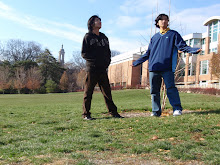I was working on my M.Sc. project and it includes using strain gage as the sensor. So I built the circuit on my own to experiment with them. Strain gage is generally a resistor made from metal foil. The resistance of strain gages change proportionately to its cross-section area when compressed or stretched. Their relationship is displayed in the equation below.
Engineers usually use strain gages to measure strains and tensions experienced by a material under certain circumstances. It is an excellent sensor that can detect the smallest deformation in the material that it is bonded to. More about strain gages can be searched in other websites.
However, the resistance change is small; in range of 1 milistrain - 1000 milistrain. This is where Wheatstone bridge come into the scene. Wheatstone bridge is a differential circuit that captures only the voltage change of a network. Then, the voltage change is amplified using differential amplifier; I prefer to use three Op amps-configuration instrumentation amplifier. After the voltage is measured using a voltmeter, the strain can be calculated and estimated using the appropriate formula depending on the network configuration you used. Below is a schematic diagram of a decent Wheatstone bridge network for quarter-bridge and half-bridge configuration.
Notice that one of the resistor is actually a potentiometer. Potentiometer is an adjustable resistor. It is used in the Wheatstone bridge to manually balanced the network to zero or set an offset to the network. When I was assembling my circuit, I noticed that my potentiometer is very vulnerable to temperature change and vibrations.
I found some interesting tips to mitigate the problem and like to share with others. One of the solution to reduce temperature change is using a potentiometer model that is covered with insulators. My previous potentiometer is exposed to the air. It could contribute change in the voltage output up to 10 mV. Meanwhile, my strain gage resistance change is less than that. Potentiometer that is equipped with insulator can help to slow the effect.
Vibrations can cause the potentiometer dial to rotate undesirably. Even small movement can affect the output significantly because of the sensitive nature of strain gages. Therefore, the potentiometer is replaced with a smaller value potentiometer in series with resistor to solve the problem.
A common strain gage value is 120 Ohm. Each arm of the Wheatstone bridge have to be 120 Ohm in order for the network to be balanced. If we were to implement the vibration resistance method, we replace the 120 Ohm potentiometer with a 10 Ohm potentiometer paired with a 110 Ohm resistor. Therefore, if vibration caused the dial to move, the change will be less significant that it might be neglected. This method also reduces the temperature effect. The smaller the potentiometer the better resistance it had with vibrations and temperature change.
Temperature change can also affect the strain gage itself. Conventionally, this can be canceled by connecting a dummy gage to its opposite arm and place it in the same area. Therefore, one strain gage will experience positive change and the other is negative and they will cancel each other out. Another way is to use strain gage that is made from constatan alloy. This alloy has a constant resistivity in a wide range of temperature. This special feature help the strain gage resistance to remain steady when temperature change occurs.
I hope this entry will help engineers that is working on D.I.Y. strain gage. Good luck!
















